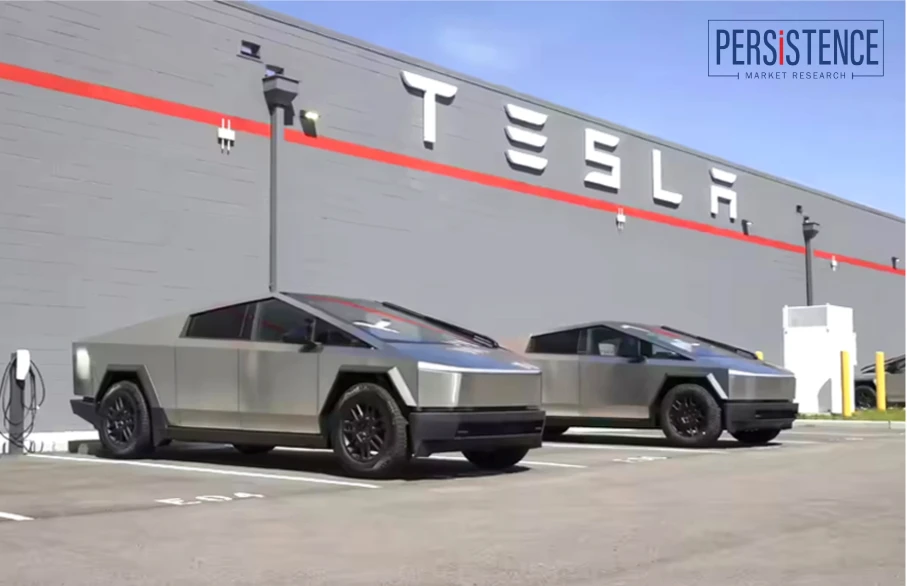- Blog
- Tesla Unexpected Results
Tesla’s Unexpected Q2 Results to Shift Gears for the EV Sector
Published On : 24 Jul 2025
Tesla's second-quarter earnings have garnered attention of analysts as well as industry watchers. The company registered a net income of US$ 1.48 billion, dispelling several forecasts and tempering speculations about its financial health.
While this is an unequivocal financial win, the performance of the auto giant is a sign of a broader evolution both within the company and across the global electric vehicle (EV) landscape.
A Promising Growth Story amidst a Changing Narrative
Tesla’s Q2 profit uptick came despite a small drop in the company’s year-over-year revenue. The company managed to offset this decline through cost-cutting efforts and a heightened focus on alternative revenue streams, such as regulatory credits and its expanding suite of software services.
Even after taking hits to its revenues, projects such as its autonomous driving technology and robotaxi platform remain central to Tesla’s long-term vision. It is also becoming increasingly apparent that the narrative around Tesla is evolving at a rapid pace.
Investors are beginning to look beyond larger-than-life innovation stories and are now instead paying closer attention to fundamentals that are more likely to deliver tangible results.
Margin pressure is mounting, and competition in the EV space is intensifying globally at an alarming speed. At the same time, consumer enthusiasm for EVs in some key markets such as the U.S. has started to cool, partly owing to questions being raised about the clean mobility claims of electric vehicles.
Given its prime position in the EV market, Tesla’s financial victory also strongly highlights the increasing role that regulatory and policy environments will play in determining the future of EVs. With the initial wave of pro-EV policies tapering in some regions, the ability of automakers to adapt to changing political climates, not just in the U.S. but also in other major economies, will have to be a crucial strategic consideration.

What Tesla’s Earnings Reveal about the Industry at Large?
If one looks beyond Tesla’s results, a few broader themes can be spotted that can potentially affect the EV industry as well as the clean technology and mobility space. One visible theme is the shifting expectations of investors. The days when visionary ideas could command market confidence on their own are now on their last legs.
Stakeholders now want clarity on how and when next-generation technologies such as AI and software innovations associated with these advancements will bring in stable returns, even if they are long-term. Execution capabilities of companies are starting to hold greater weight among stakeholders than mere ambition.
At the same time, the EV sector appears to be entering a new phase, marked less by hype and more by consolidation. Global demand for electric vehicles has started to plateau, and some of the biggest automakers are re-evaluating their EV rollouts.
In this environment, companies that can build profitable, resilient operations, without relying much on government incentives are assured to stand out. A robust EV charging infrastructure will also be critical in sustaining market momentum, ensuring that consumer adoption remains steady even as subsidies and tax credits begin to taper. Regulatory risks, in the backdrop of escalating geopolitical tensions and unpredictable shifts in countries’ political milieu, are becoming high priority. As a prerequisite, companies operating in the EV ecosystem need to think ahead. They can no longer treat tariffs, tax incentives, and raw material sourcing rules as peripheral concerns and must instead make them the core elements of business planning.
The Way Forward for EV Innovation
Tesla’s approach offers valuable lessons for adjacent industries, from battery manufacturers to players in the energy storage space. The company’s persistent investments in engineering self-driving algorithms suggest that autonomous mobility needs to be considered a long-term focus area. Cascading effects on markets such as fleet operations, sensor development, and AI model training are going to be inevitable. These investments also reinforce the idea that breakthroughs in mobility cannot be expected to just transpire from vehicles themselves; they are more likely to emerge from the software ecosystems that support them.
Moving forward, Tesla’s efforts to localize and stabilize its supply chain are reflective of a broader industry move toward building resilient systems amidst geopolitical complexities. Whether it’s securing access to rare earth minerals or adjusting manufacturing operations to align with evolving regulatory environments, flexibility and agility have emerged as essential elements for gaining a competitive advantage. Even more importantly, Tesla’s EV leadership has effectively engaged both tech and policy domains, powered by the recognition of the fact that sustainable growth requires deep and intricate collaborations across sectors.
Key Takeaways:
- Tesla’s strong second-quarter performance certainly made for eye-catching headlines, but the real story lies in the ramifications it will have on the EV industry at large,
- The EV industry is becoming increasingly complex, more competitive, and more intertwined with global economic and political currents,
- For businesses operating within or around this space, now is the time to reassess positioning from a strategic perspective,
- Success in the forthcoming phase of clean mobility will not be driven solely by leapfrogging technologies. It will heavily depend on how well companies manage uncertainty, balance ambition with delivery, and stay responsive to an enormously fluid market.
Industry Report

Request Report Sample
Your privacy is important to us; your data is secure
Contact Us
Latest Reports
-
Piezoresistive Pressure Sensor Market by Sensor Type (Absolute, Gauge, Differential, Sealed), Pressure Range (Low Pressure (<10 kPa), Medium Pressure (10 kPa – 1000 kPa), High Pressure (>1000 kPa)), End-Use Industry (Automotive & Transportation, Industrial Manufacturing, Healthcare, Aerospace & Defense, Electronics) and Regional Analysis for 2026-2033
-
Aquarium Accessories Market by Product Type (Filtration Items, Lights & Hoods, Temperature Control Systems, Others), End-User (Residential, Commercial), Distribution Channel (Online, Offline), and Regional Analysis for 2026-2033
-
Oxygen Therapy Market by Product Type (Compressed Oxygen, Concentrated Oxygen, Liquid Oxygen), Disease (Respiratory Disorder, Cardiovascular Disease, Sleep Apnea, Pneumonia), End-User (Hospitals, Home Healthcare, Clinics), and Regional Analysis for 2026-2033
-
Air Curtains Market by Product Type (Non‑Recirculating, Recirculating, Heated, Others), Airflow Capacity (Up to 500 m³/h, 500–1000 m³/h, 1000–1500 m³/h, Above 1500 m³/h), Application (Commercial, Industrial, Residential, Others), and Regional Analysis for 2026–2033
-
Personalized Stationery Market by Product type (Storage & Filling Products, Paper-Based Products, Drawing & Writing Instruments, Accessories, Bags, Others), Application (Educational Institutes, Corporate Offices, Personal Use, Hospitals, Others), and Regional Analysis for 2026–2033
